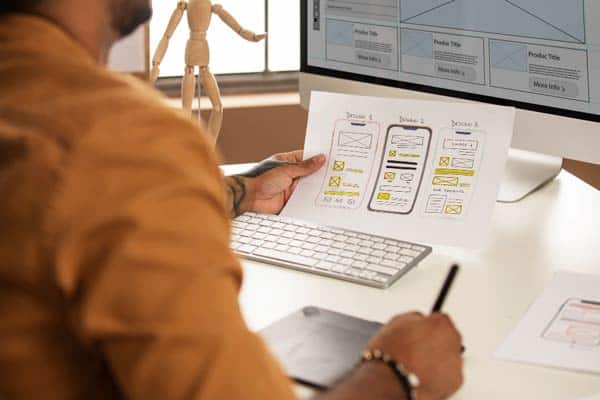Lifestyle is everywhere these days – and with good reason. It works!
What gamification adds to an app is an addictive quality, making its users keen to achieve better “scores” and return to check their performance against pre-determined goals or colleagues’ achievements.
As Professor Karl Kapp said in a Forbes article about gamification “uses game-based mechanics, aesthetics and game-thinking to engage people, motivate action, promote learning and solve problems.”
Most people have numerous apps on their phones which use gamification techniques to motivate them and promote good habits. Here are just a few popular gamification examples:
- Productivity apps
- Health and fitness apps
- Dietary or weight loss apps
- Mental health and meditation apps
- Language learning apps
- Social media apps
- Dating or social apps
- Savings or credit score apps
In different ways, all these apps leverage the same behavioral tendencies. They all offer one or more of the following rewards or nudges:
- Goal or target celebrations
- Performance metrics and graphs
- Social sharing of daily accomplishments and achievements
- Unlockable levels
- Competition with other users
- Subscription tiers and add-ons
Let’s break down a few critical components of those elements to see how they add to the effectiveness of gamification.
What is Gamification?
Gamification is the process of integrating game elements and mechanics into non-game contexts to enhance engagement, motivation, and participation. By incorporating game design elements such as points, badges, and leaderboards, gamification transforms mundane tasks into interactive and enjoyable experiences. This approach can be applied across various fields, including business, education, and marketing, to drive desired behaviors and outcomes.
For instance, in a sales environment, gamification might involve setting up a leaderboard to track sales reps’ performance, awarding badges for achieving specific milestones, or creating a points system to reward consistent effort. These game elements not only make the sales process more engaging but also foster a sense of competition and achievement among sales teams.
Benefits of Gamification
The benefits of gamification are extensive and impactful. By increasing user engagement, motivation, and participation, gamification can lead to significant improvements in sales performance, customer retention, and employee productivity. For example, sales gamification tools can transform routine tasks into exciting challenges, encouraging sales reps to push their limits and achieve higher targets.
Moreover, gamification enhances the learning experience, making it more enjoyable and effective. By incorporating game mechanics into training programs, businesses can ensure that employees are more engaged and retain information better. Additionally, gamification provides valuable insights into user behavior, enabling businesses to make data-driven decisions and refine their strategies for better outcomes.
Six Aspects of Gamification in Apps
1: Goal or Target Celebrations

A goal could be any achievement in your own life, from your step count to a daily calorie intake, minutes of meditation sustained, or sales KPIs achieved. What’s important is that the users set their own goals and are encouraged to strike a balance between ambition and achievability.
This means that, more often than not, users hit their goals, new challenges, or targets and are rewarded with a badge, medal, shout-out, or other markers of success.
2: Performance Metrics, Graphs, and Game Mechanics
Another key motivator for many people is the ability to track performance over time. Exercise apps use this strategy, graphing incremental progress as the weeks go by.
This aspect of gamification works very well in a work context, too, mapping out sales conversions, the number of calls made, or units sold. Metrics capture another popular aspect of games – the ability to compete with yourself and improve with time.
3: Social sharing of achievements
If the massive rise of social media over the last 20 years has demonstrated anything, people love sharing. Whether it’s the public leaderboard in a sales team or the activity feed on a Strava app, we enjoy celebrating one another’s achievements and receiving kudos for our own personal growth.
The best apps allow photo or video sharing, comments, likes, and other indicators of social influence. This can be one of the most abundant gamification elements, allowing a company to create a supportive community around a shared activity.
4: Unlockable levels
Modern games often use unlocking a level to reach achievement plateaus. Lifestyle gamification uses similar strategies to help users mark critical moments in their progress while building a feeling of exclusivity.
Achieving daily goals becomes addictive, ideally, with users trying to achieve a level, then moving on to the next. Of course, unlike games, many apps don’t have an ultimate goal or “big boss” to battle or “final mission” preceding completion.
Self-improvement apps work on the principle that it’s an unending mission. In other words, it’s about the journey, not the destination.
5: Competition with other users
Whether it’s a traditional leaderboard, or the ability to play and have one-to-one contests, many apps use third-party competitiveness as an essential gamification element. Users love hitting the high spots on the leaderboard or besting a friendly rival.
Often these leaderboards reset on a weekly, monthly, or quarterly basis. This means that everyone gets a chance to be the top dog now and again.
6: Subscription tiers and add-ons
Even dating apps can be thought of as using gamification. All such apps have subscription tiers, which unlock new abilities and tools. In some apps, the achievement of problematic tasks unlocks new levels. In others, users must pay to move on to the next module or level.
As well as helping monetize these apps, the notion of tiers furthers a feeling of exclusivity, which users enjoy. By paying more, people expect to receive a better, more individually tailored service, and even more rewarding.
These six elements can be combined to create apps that provide the dopamine hit that accompanies success. They make learning new skill sets fun and keep users on the path toward challenging achievements.
Understanding Your Motivations
Identifying Personal Goals and Drivers
To harness the full potential of gamification, it’s essential to understand the motivations and goals that drive you and your team. What are the key objectives you aim to achieve? What factors motivate your sales reps to perform at their best? Identifying these personal goals and drivers is crucial for designing a gamification strategy that resonates with your team and fosters desired behaviors.
Consider the specific motivations of your sales team. Are they driven by recognition, financial rewards, or personal growth? Understanding these factors will help you tailor your gamification tactics to align with their aspirations. For instance, if your sales reps are motivated by competition, incorporating leaderboards and sales contests into your gamification strategy can boost their performance and engagement.
By aligning your gamification strategy with the personal goals and drivers of your team, you can create a more effective and motivating environment. This approach not only enhances sales performance but also fosters a culture of continuous improvement and achievement.
How to Develop a Gamification App
Now that we’ve looked at the various elements of gamification apps, let’s turn our attention to how you can create an addictive, achievement-based app that users will love.
The steps below are common-sense. If you approach app development by answering the following seven questions, you’ll use gamification techniques best.
1: Who is your user base?
Before designing an app, you need to know its typical users. Different generations may have very different expectations of their apps, for instance. You can create a “user persona” of your typical users, which will help you understand what they’ll be looking for.
Is your app supposed to have a wide appeal across genders, age groups, and socioeconomic classes? That will be harder to achieve but not necessarily impossible. Is your app designed for young people or employees across the board?
2: What do your users want?
Now that you’ve decided who your ideal users are, you’ll begin to understand what they want. Are they looking for team appreciation for achieving workplace or personal goals together? Perhaps your typical user wants to live a healthier, more active lifestyle? Do they crave connection and friendship? What is the game objective?
Start with broad brushstrokes and then fill in the fine detail. Each app’s focus will be different. Even something as non-competitive as a meditation or yoga app can be aimed at absolute newcomers, improvers, or experts looking for fun ways to surpass ever-more impressive goals.
3: What are users’ motivational obstacles?
Here you come to the crux of the gamification app – what problem is your app looking to solve? It’s usually some form of motivational gap. It may take the form of a first-person statement like:
- I want to be more productive, but I can’t concentrate.
- I need to fit more phone calls into each day, but I procrastinate.
- I want to meet a life partner, but how can I find someone worthwhile?
- I would love to cook healthy meals and lose weight, but I don’t know where to start.
Each statement has an aspiration and, after the telltale, “but” an obstacle to achieving that goal. Ideally, your gamification app will identify a way to deliver a motivational boost by using the addictive and fun tricks and strategies of gamification.
4: How can you maximize time on the app?
Creating a gamified app or platform is all good, but how do you ensure people return to your creation rather than giving up at the first sign of disappointment? After all, like with a video game, a user may not succeed the first time.
This can be a difficult question to answer, and trial and error will be involved in choosing the right gamification aspects to focus upon. Do users’ motivational blocks require creating more of a supportive community? Might users return if they hit their goals and receive a corresponding reward?
Once you have narrowed your strategies, it’s time to move to the next stage, selecting the necessary gamification tools.
5: What sales gamification tools will work best?
Remember the list of six gamification aspects from before? That’s a great place to start. Think through which gamification systems will most help your app serve the goals and aspirations of its users. Again, much will depend upon the user personas you identified earlier in the development process and the specific obstacles those users face.
Here are some examples of gamification tools and tricks matched to real-life obstacles.
I want to be more productive, but I can’t concentrate.
Tools: A timer that measures focus periods, audio celebrations, and KPI tracking.
· I need to fit more phone calls into each day, but I procrastinate.
Tools: Leaderboard, milestone badges, stepped challenges, custom rewards only.
· I would like to meet a life partner, but how can I find someone worthwhile?
Tools: Rewarding potential matches, searchability, likes, and shares.
·I would love to cook healthy meals and lose weight, but I don’t know where to start.
Tools: Unlocked recipes, progress bars, milestone badges, social networking.
You can see how the nature of the app and its users’ needs will dictate what tools will work best to draw in and retain users.
6: How can you monetize your app?
This is a literal question in commercial apps, and in in-house business apps, it might be rephrased as “how can I ensure the app is cost-effective?”
The scale of your app’s game design and complexity must match the number of users you can expect to pull in within a given time. If you are an SMB with fewer than 100 employees, spending millions on a gamified onboarding app is not worth it.
However, if you can prove that your app increased productivity and profitability by an impressive percentage, it may be worth making a significant investment if the company is expanding.
So long as you can produce enough monetary reward or value from your gamified app, investment is worthwhile.
7: How can your app develop over time?
Apps, particularly ones using a gamification system, will always need to develop and improve over time. You must create a development schedule addressing how often you’ll update the app, fix any glitches or security issues, and release new gamification features.
You want to avoid users becoming complacent or bored with your product so they stop using it.
The Process of App Gamification Development

Designing and developing a gamification app is not very different from launching any other product type. However, one significant advantage of such apps is that they retain masses of data about user performance and behavior.
You can use this data to identify app features that are most popular or undervalued. This will help your development team improve your app’s vulnerabilities and innovate new gamification strategies to maximize usage and performance.
You can also monitor social channels, review sites, and other places where users talk about their experiences of using your app. Research sources may include:
- Intranet social site chatter (i.e., Slack channels)
- External review sites (i.e., G2 and Capterra)
- Social media mentions (i.e., Twitter, Facebook)
- In-person focus groups
- Market research findings (i.e., user surveys)
Combining what people say about your gamification app and how they interact with it, you can build a composite portrait of your creation’s usefulness and success.
Top Advantages of Using Gamification in App Development for Sales Performance
Let’s finish by exploring some compelling reasons and statistical findings that highlight the effectiveness of incorporating gamification measures in your app.
As noted by Harvard Business Review back in 2015, “Motivation experts like Dan Pink would say that games are tapping into some basic human drives: for autonomy (you control your own pace), for mastery (you get better over time), and for a sense of purpose (you’re aiming at a well-defined goal).” These elements of game mechanics are instrumental in enhancing user engagement and motivation, driving them towards achieving their personal and professional goals.
More recently, Business Insider observed how even financial institutions are leveraging gamification to boost user engagement and retain customers: “Some banks are introducing game-like environments in their mobile apps and online that promote completing financial tasks. Each task earns the user a point or bumps them to a new level.
Other banks use digital platforms to show consumers videos or assign them learning-related tasks to promote financial literacy.” This approach not only encourages users to engage more frequently with their financial tools but also promotes a deeper understanding of financial management through interactive learning.
Furthermore, gamification has proven to be a powerful tool in various other sectors. For instance, in the corporate world, sales managers are utilizing gamification tools and techniques to engage their teams, implement competitions, track performance, and foster a competitive spirit.
By incorporating game elements such as leaderboards, achievement badges, and progress bars, companies can create a sense of healthy competition among sales reps, driving them to achieve higher sales targets and enhancing the overall sales process. Integrating gamification into a sales strategy can significantly enhance sales effectiveness, as seen in specific cases like Acrisure’s success in increasing revenue through innovative tactics.
In education, gamification strategies are employed to make learning more interactive and enjoyable, helping students to retain knowledge more effectively. This is achieved by integrating gaming elements such as challenges, rewards, and social feeds into the learning process, which keeps students motivated and engaged.
The benefits of gamification extend beyond individual users to entire organizations. By fostering an environment of continuous improvement and engagement, businesses can see significant increases in productivity and employee satisfaction. In fact, gamification has been shown to increase participation and motivation among employees, leading to better team collaboration and achievement of company goals.
Overall, the integration of gamification principles into apps and platforms is not just a trend but a strategic approach to enhance user experience, drive engagement, and achieve desired outcomes. Whether it’s boosting productivity, improving customer retention, or enhancing learning experiences, gamification offers a versatile solution that taps into human motivation and the innate desire for achievement and recognition.
Spinify is the answer
Gamification is on the rise across the board. Recent research has shown that:
- 80% of US workers find gamified learning more engaging.
- Employers see a 60% rise in employee engagement using gamification.
- 50% of businesses see increased productivity due to gamified training tools.
Sales gamification work is utilized to enhance motivation and performance among sales representatives by turning monotonous tasks into engaging games, fostering competition, and increasing rewards for reaching goals.
There’s no question that lifestyle gamification is here to stay; we are all gamers at heart. If you’d like to know more about how gamification can improve your productivity, or the health and well-being of your employees, then check out our product demo.
Set your team up for success by improving their performance through gamification.




